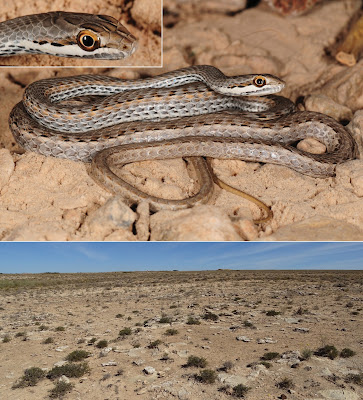 |
| Psammophis cornusafricae Šmíd, Fernández, Elmi & Mazuch, 2023 |
Abstract
The biological diversity of the Horn of Africa is one of the least studied in the world. Yet the Horn supports rich communities of species that are mostly endemic to the region. Here we study the diversity of Sand Snakes (Psammophis) in East Africa, their phylogeny and systematics. Previous studies have unveiled several cryptic and potentially undescribed species of Psammophis that occur in the Horn and their taxonomic status has remained unclear to this day. We used sequence data from two mitochondrial and one nuclear genes to reconstruct the phylogeny of the genus, in which we included newly obtained samples of six different Psammophis species from Somalia, Ethiopia, Eritrea, Sudan, and Egypt. Our aim was to assess the status of some of the undescribed species, examine the level of intraspecific genetic variation within individual species, improve our understanding of the species distributions, and contribute to the taxonomy of the genus. Our results confirm the existence of two undescribed species, one in eastern Somalia, which we formally describe as new, and one in southern Ethiopia that we refer to as Psammophis cf. sudanensis in accordance with previous studies. Further, we provide first genetic data for the nominotypical subspecies of P. punctulatus and confirm the species status for its subspecies P. trivirgatus. In addition, we provide new genetic data for P. tanganicus from Ethiopia and Somalia, and range extension records for P. rukwae from Eritrea and Ethiopia and for P. aegyptius from Somalia. Our findings contribute considerably to our understanding of the diversity and distribution of Psammophis in East Africa.
Key Words: East Africa, Eritrea, Ethiopia, phylogeny, Reptilia, sand racers, Serpentes
Psammophis cornusafricae sp. nov.
Diagnosis: A Psammophis species sister to P. tanganicus, with the following combination of morphological characters: 11 infralabials; 9 supralabials, three of which are in contact with the eye; nostril pierced between two equal sized nasals; 15 anterior dorsals; 14–15 midbody dorsals; 11 posterior dorsals; 146–158 ventrals; 95–100 subcaudals. Body brown, grey or beige with only a faintly visible pale vertebral stripe but with well pronounced dorsolateral orange stripes on each side of the body. Tail with only a slight trace of or completely lacking any dark vertebral stripe; the posterior half of the tail uniformly pale yellow. Venter white to yellowish with a conspicuous stipple of irregular dark smears. Head dorsally with a symmetrical pattern of brown markings outlined by black margins which contrast with the grey or beige background coloration. Labials white with dark margins forming a black lip. Dark brown temporal stripe outlined by black blotches and stretching from the eye to the posterior end of the head.
English name: African Horn Sand Snake Somali name: Subxaanyo [pronounced Subhanyo]; a term in the Somali language that refers to all Psammophis species that occur in the region. All Subxaanyo are believed to be harmless and friendly by the locals and are an important part of their folklore
Etymology: The species epithet indicates the geographic origin of the species and translates as “The Sand Snake of the Africa’s Horn”. It is a noun in the genitive case that is derived from the Latin words for horn (cornu-us) and Africa (Africa-ae).
Jiří Šmíd, Sergio Matilla Fernández, Hassan Sh Abdirahman Elmi and Tomáš Mazuch. 2023. Diversity of Sand Snakes (Psammophiidae, Psammophis) in the Horn of Africa, with the Description of A New Species from Somalia. Zoosystematics and Evolution. 99(2): 345-361. DOI: 10.3897/zse.99.101943




